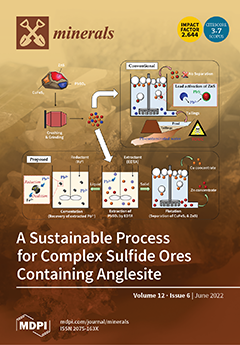A complete series of the calcite–otavite solid solutions [(Ca
1−xCd
x)CO
3] were prepared, and their dissolution processes lasting nine months were experimentally investigated. For the dissolution in the N
2-degassed water, the Ca concentrations of the aqueous phases
[...] Read more.
A complete series of the calcite–otavite solid solutions [(Ca
1−xCd
x)CO
3] were prepared, and their dissolution processes lasting nine months were experimentally investigated. For the dissolution in the N
2-degassed water, the Ca concentrations of the aqueous phases increased up to the steady states after 5040 h of dissolution, and the Cd concentrations of the aqueous phases increased up to the highest values and then decreased gradually to the steady states of 0.017–6.476 μmol/L after 5040 h of dissolution. For the dissolution in the CO
2-saturated water, the Ca and Cd concentrations of the aqueous phases increased up to the peak values and then decreased gradually to the steady states of 0.94–0.46 mmol/L and 0.046–9.643 μmol/L after 5040 h of dissolution, respectively. For the dissolution in the N
2-degassed water at 25 °C, the mean solubility products (log
Ksp) and the Gibbs free energies of formation (Δ
Gfθ) were estimated to be −8.45–−8.42 and −1129.65–−1129.48 kJ/mol for calcite [CaCO
3] and −11.62–−11.79 and −671.81–−672.78 kJ/mol for otavite [CdCO
3], respectively. Generally, the log
Ksp values decreased non-linearly, and the Δ
Gfθ values increased linearly with the increasing Cd/(Ca+Cd) mole ratio (X
Cd) of the (Ca
1−xCd
x)CO
3 solid solutions. In the Lippmann diagrams constructed for the sub-regular (Ca
1−xCd
x)CO
3 solid solutions with the estimated Guggenheim coefficients
a0 = −0.84 and
a1 = −3.80 for the dissolution in the N
2-degassed water or
a0 = −1.12 and
a1 = −3.83 for the dissolution in the CO
2-saturated water, the (Ca
1−xCd
x)CO
3 solid solutions dissolved incongruently, moved progressively up to the quasi-equilibrium curves for otavite and then along the quasi-equilibrium curve from right to left, approached the
solutus curve and finally reached the minimum stoichiometric saturation curve for calcite. The considerably Cd-poor aqueous phases were finally in equilibrium with the CdCO
3-rich solid phases.
Full article





